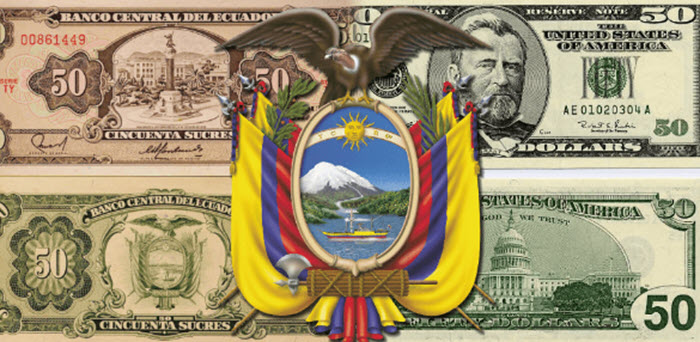“Dollarization is the best barrier to defend (the poor especially) from political crises,” declares the “father of dollarization” in Ecuador.
The dollarized economy in Ecuador is turning 20. Amid a continent shaken by political instability driven by the region’s left, Ecuador has maintained low inflation and a stable currency.
At the time of its disappearance in 1999, the Ecuadorian currency of Republican times, the value of the sucre fell from 4,000 per dollar to 17,000 dollars to 25,000 per dollar. The instability, not only economic but also social and even emotional, of waking up every day with a different currency value, came to an end and has remained that way for two decades.
PanAm Post spoke with Franklin Lopez Buenaño, the economist named “the father of dollarization” by fellow economist Pablo Lucio Paredes. Though Lopez prefers to call himself the “intellectual protagonist of dollarization.” Together with Joyce de Ginatta, he formed the Economic Forum, composed of 20 economists who supported dollarization in 1999. They toured the country, debated at universities, and appeared on radio and television to explain to Ecuador the need to change its currency.
What was your role in the dollarization of the economy?
I will tell you a personal anecdote because, at my age, I can afford the luxury of vanity. When the government of Jamil Mahuad explained the decision of dollarization to the members of Congress (now called Assembly Members), Alfredo Arizaga, then Minister of Finance, showed my book Why and How to Dollarize, and told them to refer to the book if they wanted to know more about dollarization. To which Juan José Pons (President of Congress), who had seen me, said, “The author is around.” When the session was over, Paco Moncayo came up to me and said, “All this is your fault.” I was speechless and didn’t know how to respond.
Was dollarization necessary in Ecuador?
It was necessary. Inflationary expectations had run wild, and even the 100% interest rate was not enough. Sixty percent of the bank’s liabilities were in dollars, not counting those “under the mattress.” The only things that were not dollarized were salaries and pensions.
Behind the scenes, some exporters and importers had dollar exchange agreements. We could say this: an exporter gave the importer dollars, and the importer paid Ecuadorian sucres, those dollars did not enter Ecuador. It was not possible to quantify the amount of these exchanges, but I imagine that they were considerable.
When the dollar was introduced, importers no longer needed this mechanism, and the dollars that came in were a noteworthy factor in the solidification of dollarization. Moreover, the credibility gained by the country contributed to exceptional growth in non-oil and non-traditional exports. The export factor was stronger than the income from remittances (which shatters the myth that migrants have sustained dollarization).
he social benefit was immense, especially for vulnerable sectors: employees with fixed salaries and retirement pensions. The pensions had reached seven dollars a month. The poor and lower middle class could not defend themselves from inflation because their income was not sufficient to cover their expenses. Meanwhile, those in the higher classes had surpluses that allowed them to buy dollars. Money-changers on the streets in front of the banks were plentiful because people hoarded dollars from what they could save. Poverty reduction is the most significant of the benefits of dollarization.
In contrast to the other countries in the region, how has Ecuador stood out after adopting this currency?
In the first ten years, all the statistical data show that economic growth (an average of 4.7%) was among the highest in the region. Monetary stability was, in my opinion, more important than the dollar’s devaluation factor that drove exports. The fact that devaluation stimulates exports is a fallacy because otherwise Ecuador at that time, like Argentina and Venezuela at this time, would have been a tremendous exporter. Devaluations are always accompanied by inflation; they are two concurrent phenomena. I give an example of the opposite; Hong Kong developed its exports because they had a credible convertibility system, and this attracted foreign investment dedicated to exports. Credibility and monetary stability are much more powerful factors than devaluation.
What are the disadvantages of dollarization (export, etc.)?
The costs of “non-dollarization” are much higher than the supposed losses in competitiveness. In reality, the damages instead arise from what was not done. The central bank had to be eliminated (by the way, when I was invited to be a member of the bank’s board, many people opposed it because I was going to “turn off the light,” and I would have done it). And much more important: the banking laws were not changed to allow financial integration, as is Panama with more than 80 international banks. Competition would have caused the reduction in banking costs (interest rates and charges), of which many “influencers” complain.
Do you recommend other countries to dollarize?
We see that Venezuela and Argentina are suffering from hyperinflation. The unrest in Chile devalued their currency. My co-authors and I wrote a book on why and how to dollarize Bolivia and Honduras. When I spoke with the Nicaraguan Minister of Finance in Violeta Chamorro’s government, he confessed to me that if he had known about dollarization, this is what he would have done to remedy the hyperinflation of the Sandinista government. In other words, my recommendation is that because of the uncertainties, which cast a shadow over the region, dollarization is the best barrier for defending oneself (the poor especially) from the political crises that can arise from the violence of the demonstrations. Monetary stability is a shield against political or social crises. For example, in Ecuador, two presidents were overthrown, and in October of last year, the demonstrations were violent, which would undoubtedly have caused a devaluation. It did not happen. Meanwhile, the Bolivian and Chilean currencies did suffer.
